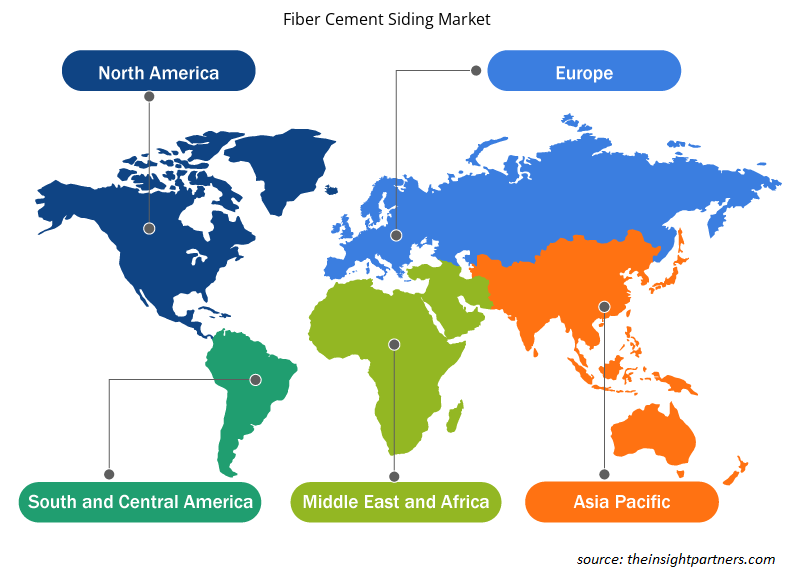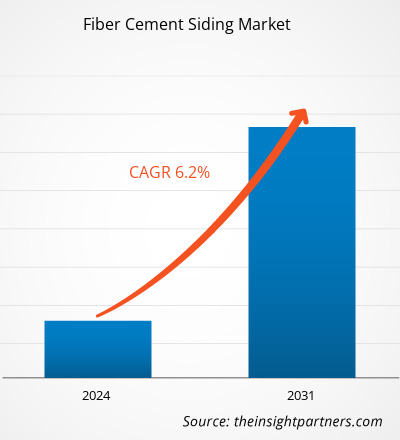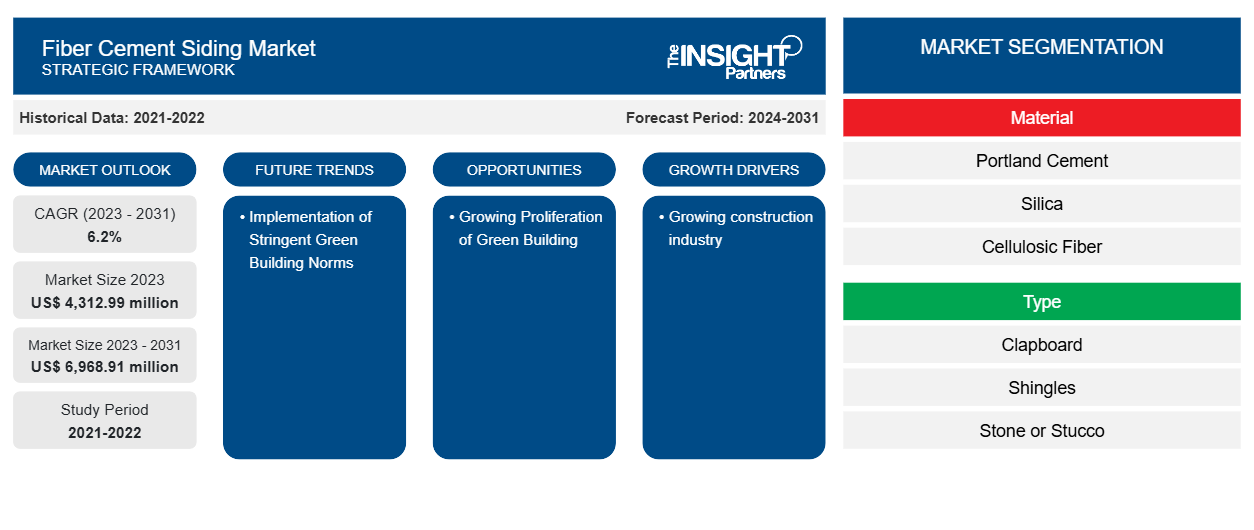Se proyecta que el tamaño del mercado de revestimiento de fibrocemento alcance los 6.968,91 millones de dólares estadounidenses en 2031, frente a los 4.312,99 millones de dólares estadounidenses en 2023. Se espera que el mercado registre una CAGR del 6,2 % durante el período 2023-2031. Es probable que el creciente número de desarrollos de infraestructura residencial y comercial y el enfoque cada vez mayor en aprovechar el revestimiento de cemento rentable sigan siendo una tendencia clave en el mercado.
Análisis del mercado de revestimientos de fibrocemento
Se prevé que el creciente desarrollo del sector de la construcción aumente el desarrollo de revestimientos de fibrocemento a nivel mundial. La industria de la construcción en países desarrollados como Estados Unidos, Canadá y el Reino Unido, entre otros, ha estado creciendo a un ritmo significativo en los últimos años. Los gobiernos de estos países están fomentando las asociaciones público-privadas para implementar obras residenciales, comerciales y de infraestructura. Esto ha llevado a una mayor construcción de edificios residenciales y comerciales a nivel mundial en los últimos tiempos, lo que está fomentando el crecimiento del mercado de revestimientos de fibrocemento.
Descripción general del mercado de revestimiento de fibrocemento
Se prevé que el aumento de la construcción de edificios residenciales y comerciales proporcione oportunidades prósperas para que el mercado crezca a nivel mundial, lo que repercutirá positivamente en la demanda de revestimientos de fibrocemento. Junto con eso, los proyectos de ciudades inteligentes también están actuando como un impulsor del mercado de revestimientos de fibrocemento. Los mayores ingresos disponibles de las personas debido a la prosperidad económica han sido un factor importante que ha impulsado el mercado de revestimientos de fibrocemento en el sector de los edificios residenciales. Por lo tanto, el creciente número de actividades de construcción está generando una demanda positiva de revestimientos de fibrocemento a nivel mundial.
Personalice este informe según sus necesidades
Obtendrá personalización en cualquier informe, sin cargo, incluidas partes de este informe o análisis a nivel de país, paquete de datos de Excel, así como también grandes ofertas y descuentos para empresas emergentes y universidades.
-
Obtenga las principales tendencias clave del mercado de este informe.Esta muestra GRATUITA incluirá análisis de datos, desde tendencias del mercado hasta estimaciones y pronósticos.
Factores impulsores y oportunidades del mercado de revestimientos de fibrocemento
Creciente desarrollo en la industria de la construcción favorecerá al mercado
El crecimiento de la población ha dado lugar a una gran demanda de actividades de construcción residencial y comercial a nivel mundial. Regiones como Europa, América del Norte, Asia Pacífico y Oriente Medio comprenden varios países en desarrollo, que generan una sólida demanda de proyectos de infraestructura. El aumento de la población de estos países es el principal impulsor de la industria de la vivienda de la región, lo que impulsará el mercado de revestimiento de fibrocemento a nivel mundial. Con el auge de la construcción de edificios comerciales y residenciales, el mercado de revestimiento de fibrocemento está aumentando en varios países como China y Japón debido a varios beneficios, como ahorros de energía y costos a largo plazo, menores emisiones e impacto ambiental general, mejor confort térmico y consiste en ventilación continua y aire fresco en todo el edificio conduce a una mejor comodidad y salud. El concepto creciente de edificios energéticamente eficientes también está impulsando el crecimiento del mercado de revestimiento de fibrocemento.
Creciente proliferación de edificios ecológicos
Varias iniciativas gubernamentales para introducir edificios energéticamente eficientes y respetuosos con el medio ambiente están impulsando la demanda del mercado de revestimiento de fibrocemento. Por ejemplo, Alemania y el Reino Unido son los principales países que se centran en la construcción de edificios energéticamente eficientes debido a las respectivas inversiones gubernamentales. Este factor está impulsando el crecimiento del mercado de revestimiento de fibrocemento. Se espera que el avance tecnológico para el desarrollo de los sectores de la vivienda residencial y comercial en línea con los objetivos de sostenibilidad medioambiental atraiga a los actores locales y globales para ofrecer revestimientos de fibrocemento de calidad, que se prevé que aumenten las oportunidades para el mercado durante el período de pronóstico.
Análisis de segmentación del informe de mercado de revestimiento de fibrocemento
Los segmentos clave que contribuyeron a la derivación del análisis del mercado de revestimiento de fibrocemento son el tipo de producto, la aplicación y el usuario final.
- Según el material, el mercado de revestimiento de fibrocemento se divide en cemento Portland, sílice, fibra celulósica y otros. El segmento de cemento Portland tuvo una mayor participación de mercado en 2023.
- Por tipo, el mercado está segmentado en tablillas, tejas y piedra o estuco. El segmento de tablillas tuvo una participación significativa del mercado en 2023.
- Por usuario final, el mercado se segmenta en residencial y comercial. El segmento residencial tuvo una participación significativa del mercado en 2023.
Análisis de la cuota de mercado de revestimiento de fibrocemento por geografía
El alcance geográfico del informe del mercado de revestimiento de fibrocemento se divide principalmente en cinco regiones: América del Norte, Asia Pacífico, Europa, Medio Oriente y África, y América del Sur y Central.
América del Norte lidera el mercado. La economía de América del Norte se considera una de las más grandes del mundo. Los países norteamericanos comprenden algunas de las empresas multinacionales más grandes en sus territorios. Estados Unidos tiene un mayor número de actores del mercado de revestimiento de fibrocemento en comparación con el mundo. Las empresas de construcción ubicadas en la región se benefician de las instalaciones desarrolladas disponibles. Ser una economía sólida permite al gobierno gastar más en obras de construcción para una mayor urbanización. Esto también ayuda en la construcción de edificios en la región, lo que respaldará el crecimiento del mercado de revestimiento de fibrocemento en la región.
Perspectivas regionales del mercado de revestimiento de fibrocemento
Los analistas de Insight Partners explicaron en detalle las tendencias y los factores regionales que influyen en el mercado de revestimientos de fibrocemento durante el período de pronóstico. Esta sección también analiza los segmentos y la geografía del mercado de revestimientos de fibrocemento en América del Norte, Europa, Asia Pacífico, Oriente Medio y África, y América del Sur y Central.

- Obtenga datos regionales específicos para el mercado de revestimiento de fibrocemento
Alcance del informe de mercado de revestimiento de fibrocemento
| Atributo del informe | Detalles |
|---|---|
| Tamaño del mercado en 2023 | US$ 4.312,99 millones |
| Tamaño del mercado en 2031 | US$ 6.968,91 millones |
| CAGR global (2023 - 2031) | 6,2% |
| Datos históricos | 2021-2022 |
| Período de pronóstico | 2024-2031 |
| Segmentos cubiertos |
Por material
|
| Regiones y países cubiertos |
América del norte
|
| Líderes del mercado y perfiles de empresas clave |
|
Densidad de actores del mercado: comprensión de su impacto en la dinámica empresarial
El mercado de revestimientos de fibrocemento está creciendo rápidamente, impulsado por la creciente demanda de los usuarios finales debido a factores como la evolución de las preferencias de los consumidores, los avances tecnológicos y una mayor conciencia de los beneficios del producto. A medida que aumenta la demanda, las empresas amplían sus ofertas, innovan para satisfacer las necesidades de los consumidores y aprovechan las tendencias emergentes, lo que impulsa aún más el crecimiento del mercado.
La densidad de actores del mercado se refiere a la distribución de las empresas o firmas que operan dentro de un mercado o industria en particular. Indica cuántos competidores (actores del mercado) están presentes en un espacio de mercado determinado en relación con su tamaño o valor total de mercado.
Las principales empresas que operan en el mercado de revestimiento de fibrocemento son:
- Grupo Swisspearl AG
- RSE limitada
- Elementia SAB DE CV
- Grupo ETEX
- Corporación de materiales GAF
- Industrias James Hardie Plc
Descargo de responsabilidad : Las empresas enumeradas anteriormente no están clasificadas en ningún orden particular.

- Obtenga una descripción general de los principales actores clave del mercado de revestimiento de fibrocemento
Noticias y desarrollos recientes del mercado de revestimientos de fibrocemento
El mercado de revestimientos de fibrocemento se evalúa mediante la recopilación de datos cualitativos y cuantitativos posteriores a la investigación primaria y secundaria, que incluye publicaciones corporativas importantes, datos de asociaciones y bases de datos. A continuación, se enumeran algunos de los avances en el mercado de revestimientos de fibrocemento:
- Swisspearl Group, con sede en Niederurnen (Suiza), adquirió la danesa Cembrit. (Fuente: Swisspearl Group, comunicado de prensa, junio de 2022)
- James Hardie Industries Plc adquirió un terreno en Melbourne, Victoria, para establecer una planta de placas de fibrocemento. (Fuente: James Hardie Industries Plc, comunicado de prensa, marzo de 2022)
Informe de mercado de revestimiento de fibrocemento: cobertura y resultados
El informe “Tamaño y pronóstico del mercado de revestimiento de fibrocemento (2021-2031)” proporciona un análisis detallado del mercado que cubre las siguientes áreas:
- Tamaño del mercado de revestimiento de fibrocemento y pronóstico a nivel mundial, regional y nacional para todos los segmentos clave del mercado cubiertos bajo el alcance
- Tendencias del mercado de revestimientos de fibrocemento, así como dinámica del mercado, como impulsores, restricciones y oportunidades clave
- Análisis PEST y FODA detallados
- Análisis del mercado de revestimiento de fibrocemento que abarca las tendencias clave del mercado, el marco global y regional, los principales actores, las regulaciones y los desarrollos recientes del mercado
- Análisis del panorama de la industria y de la competencia que abarca la concentración del mercado, el análisis de mapas de calor, los actores destacados y los desarrollos recientes del mercado de revestimientos de fibrocemento
- Perfiles detallados de empresas
- Análisis histórico (2 años), año base, pronóstico (7 años) con CAGR
- Análisis PEST y FODA
- Tamaño del mercado, valor/volumen: global, regional y nacional
- Industria y panorama competitivo
- Conjunto de datos de Excel
Informes recientes
Informes relacionados
Testimonios
Razón para comprar
- Toma de decisiones informada
- Comprensión de la dinámica del mercado
- Análisis competitivo
- Información sobre clientes
- Pronósticos del mercado
- Mitigación de riesgos
- Planificación estratégica
- Justificación de la inversión
- Identificación de mercados emergentes
- Mejora de las estrategias de marketing
- Impulso de la eficiencia operativa
- Alineación con las tendencias regulatorias























 Obtenga una muestra gratuita para - Mercado de revestimientos de fibrocemento
Obtenga una muestra gratuita para - Mercado de revestimientos de fibrocemento